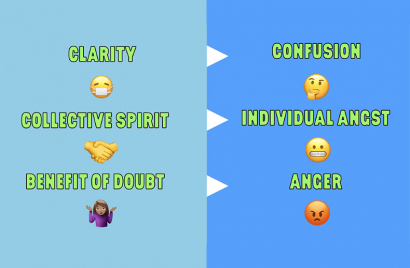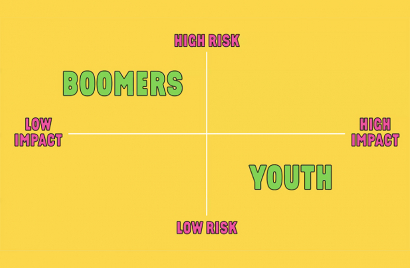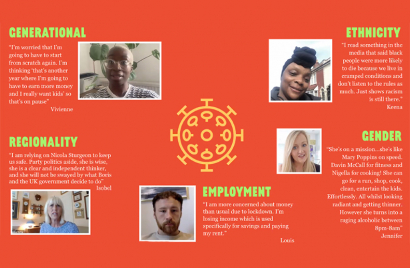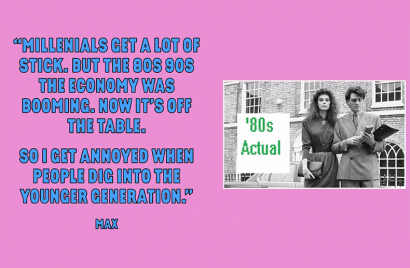
Tesco Mobile and BBH London use humour to showcase the network’s connectivity
‘It Pays to be Connected’ reaches consumers with relatable circumstances

Research from Mother and davies+mckerr has unpacked how consumer behaviour is really shifting under lockdown.

Lockdown has produced many articles full of speculation about what the future will bring for consumers; it is perhaps the only thing we can do when we try to imagine the industry landscape moving forward. Yet the only real way to get a gauge on what’s really going on, how people are feeling and what behavioural habits are emerging, or disappearing is to simply ask them.
This is something that Mother London has been doing in partnership with davies + mckerr in an ongoing research series entitled simply; What’s Going On? Over the last 12 weeks, 24 participants across five locations have been giving their insight into life under lockdown. From one-on-one chats to group discussions, the participants have posted videos and community posts exploring everything from how they’re adjusting to what they’re eating, watching or spending their money.
The research was designed to give an insight into what’s really going on to help the industry prepare for the future and understand it better, as Matt Tanter, Mother London’s Head of Strategy outlined when he opened a recent event presenting the latest research. For Tanter, this research is “looking for tensions, things that aren’t clear on the surface, not just the averages that sometimes hide the grit.
The research identified three big tensions at play at the moment:


Alongside Tanter, Tom Anderson, Partner at davies + mckerr presented the first tension that examined the reality that the country is not having a unified experience of lockdown. There are other factors at play, from ethnicity to age to regionality and gender. These factors already existed but have been exacerbated by the current crisis.
This means that when it comes to coping, consumers are all doing so in different ways. Perhaps the only unifying feature is the instinct of individuals to simply say ‘I’m fine’, even when in reality they are anything but. The research revealed that coping mechanisms are differing, with some people looking to replicate the experience of life before lockdown, while others are using the time to explore new things or to fantasise about what life will look like in the future.
Anderson revealed that the mood has shifted over the last 12 weeks. With many having gone from a state of clarity to a position of confusion; from collective spirit to individual angst. Consumers have stopped giving each other the benefit of the doubt and have instead moved to anger. Anderson emphasised that while people may not be selfless, what the lockdown is proving is that neither are they selfish.
When it comes to lessons brands can take from unpacking this tension, Anderson said that first up, brands shouldn’t be treating people like victims; don’t patronise. Another point was around whether brands look to unity or identity, while the third suggested that brands should make local a start point not an end point. The final suggestion looked to how brands might use the constraint we find ourselves in, in imaginative ways to help people’s post-lockdown lives live up to the fantasy they’ve been building in their minds.
Scarlett Spence, Strategy Director at Mother London introduced the second tension, which is around the impact this crisis is having on differing generations. She spoke of a metric graph which positioned boomers and the youth at different ends of the same spectrum. While the older generations are ultimately high risk, they are relatively low impact in terms of the life shift. Youth at the complete opposite, meaning there will be significant long-term impact on those generations.
One issue that Gen Z are facing is ‘formative fomo’, as key moments in their lives are cancelled or postponed. From proms to exams to finishing school, many life defining moments no longer exist for this generation, and they’re leaving giant holes.
When it comes to the millennial generation, what’s vital, says Spence is that marketers reframe how they are perceived and talked about. They’re a generation that has experienced a lot and, as such, have the resilience to weather each storm; ‘snowflake’ they most definitely are not.
For brands, they need to recognise the milestones that matter to the younger generations; to recognise the sacrifice many are making by listening to and acknowledging what they’ve been through; and to understand that frustration can be positive energy.
The third tension explored the nature of what entertainment looks like under lockdown. How are brands helping to combat the sense of monotony and boredom that permeates? As one person remarked to Tanter, “for an unprecedented event, everyday feels pretty precedented.”
People are actively looking for joy; they want to escape, and this desire has signified the rise of the entertainer. What has happened is that everything is now entertainment; it is proliferating into every part of the day as consumers more actively consume content.
Brands are exploring different formats as they listen and respond to what their consumers want. Whether that’s the hairdressing salon Bleach London hosting a virtual salon or Travis Scott performing for 12 million people on Fortnite, the crisis has blown open ideas around collective entertainment.
Tanter believes that this is an opportunity for brands to play with new formats and to mould entertainment around rituals. It’s a chance to re-imagine events and help people go beyond their bubble. Fundamentally, it’s a moment for brands to embrace the cult in culture; what starts small can often move and grow to become something even greater.


Looks like you need to create a Creativebrief account to perform this action.
Create account Sign inLooks like you need to create a Creativebrief account to perform this action.
Create account Sign in